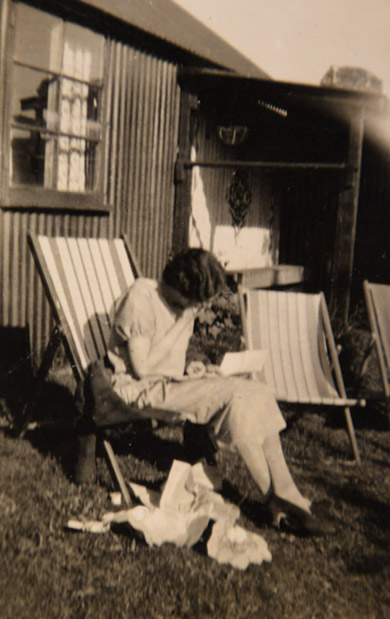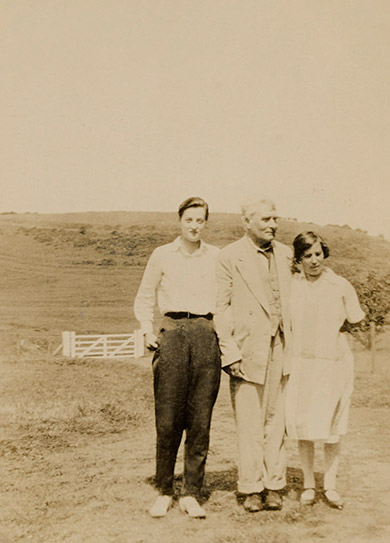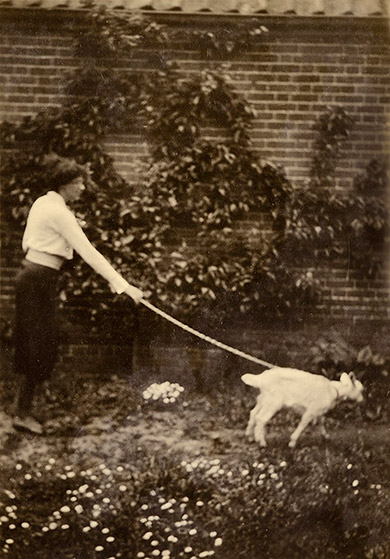Judith Stinton
Sylvia Townsend Warner first went to Chaldon Herring in 1922. She was taken there by her friend the sculptor Stephen Tomlin to visit his discovery, ‘a most remarkable man living just beyond the village. He is a sort of hermit and he has a very fine head. He reads Dostoievsky’.
The owner of the head (which was soon to be sculpted by Tomlin) was Theodore Francis Powys, struggling author of a series of gospel commentaries and of the rather peculiar Soliloquies of a Hermit which pondered on his life and his uneasy relationship with God. Powys had deliberately chosen to live in a small and unobtrusive village, concealed in a green valley between the ancient Ridgeway and the cliffs. The gated lane to the main road meandered around the village and back again. His house, Beth Car, was the only brick dwelling among the flint, stone and thatch of his neighbours. Theodore relished this fact. ‘I do not know that I have seen a cottage so much like a doll’s house as ours’, he wrote. ‘An ugly one, too.’
Theodore had married into the village: his wife Violet was a Chaldon girl. Like his writing brothers, John Cowper and Llewelyn, he was no feminist, but he seemed to make an honourable exception for Sylvia Townsend Warner. He admired her erudition, her quick intelligence and her wit. Warner soon became a warm friend of both Theodore and Violet, and in her turn was fascinated by Powys, by his pessimism, his obsession with God and death and his goblin humour. She even began to write a book about him, called Animae Effigies, which she abandoned when she discovered just how little he liked the idea.
By the time they met, Theodore had drawers full of manuscripts, and Sylvia, along with Tomlin and her fellow-writer David Garnett, succeeded in finding Powys a publisher. In 1923 The Left Leg was published by Chatto & Windus, the first of many of his short stories and novels to appear under this imprint.
Chaldon was now becoming an artistic colony. When Garnett visited Theodore he stayed in the village inn, The Sailor’s Return, and wrote a novel of the same name about it. Soon Llewelyn Powys would move into a coastguard’s cottage up on the cliffs, and T. E. Lawrence would ride over from Bovington on his motor bike. Members of the Bloomsbury Group, such as Lady Ottoline Morrell and the painter Dora Carrington, also visited Theodore. The sculptor Elizabeth Muntz rented a cottage in the village.
Sylvia’s own first book was The Espalier (1926), a poetry collection which included poems about the village, such as ‘Ghosts at Chaldon Herring’ and ‘The Green Valley’, and other verses involving some of Theodore’s characters. Her fiction of the early 1930s shared some of Theodore’s preoccupations. Clergymen abound in both writers’ work from this period. Theodore’s priests, like Reverend Silas Dottery – or Mr. Grobe in his finest novel, Mr. Weston’s Good Wine – are gentle, unworldly and ineffectual. Higher clergy, such as bishops, are satirised. The unhappy young Arthur Clay in Sylvia’s story ‘Early One Morning’ is outwitted even at her death by the village witch. Timothy Fortune in her second novel (1927) is a missionary who in three years succeeds in making only one convert.
Powys and Warner benefited from reading each other’s work. Powys’s writing was effectively economical, as sparing of imagery as the village was with trees. Sometimes, as in his early novel Mr. Tasker’s Gods, it could be grim to the point of absurdity. Conversely, the exuberance of Warner’s work could spill over into a frivolity bordering on silliness. Each acted as a check on the other. There’s a story of Theodore’s, ‘A Suet Pudding’, where an abused wife gets a stinging revenge on her husband, which could equally well have been written by Warner.
The friendship between Sylvia, Theodore and Violet was to cool somewhat, at least for a while, when Sylvia began to live with the poet Valentine Ackland. In 1930 she had bought ‘the late Miss Green’s cottage’ opposite the inn, a ‘small and undesirable residence’ (as the surveyor put it), with two rooms on each floor, a cold water tap and an oil stove. For Sylvia it was a ‘little snub-nosed squat Victorian house’ and, importantly, the only freehold house in this estate village. Intending to live there only intermittently, Sylvia asked Valentine if she would be willing to share it. They both moved in, and shortly afterwards became lovers.
Valentine Ackland’s first visit to Chaldon had been in 1925 when she was taken by a friend to meet Theodore. Valentine was in flight from a brief and disastrous marriage, to which she never returned. She was a striking figure: tall and thin with cropped hair and masculine clothes. No one in Chaldon had seen a woman in trousers before.
Valentine’s union with Sylvia was the start of a life-long partnership, and the years in Chaldon were their happiest times. They battled with the garden, ate Sylvia’s inventive food and worked on their writings. Sylvia kept a detailed diary and wrote countless letters, lively, humorous and sharp.
As well as their friendships with members of the Powys family, and their many visitors, Sylvia and Valentine were close to some of the villagers, especially Mr. Goult the carrier, ‘Grannie’ Moxon and Shepherd Dove. Annie Moxon is the subject of several of Sylvia’s poems, including the epic Opus 7 of 1931. ‘Rebecca’ as she is called, has green fingers, but wilfully grows flowers instead of sensible vegetables like the rest of the villagers. In this fantastical poem, her success in cultivating flowers enables her to buy drink, which becomes her downfall.
Chaldon was a farming village, dominated by its barns. ‘Even the ricks and haystacks overtop the roofs of thin slate or threadbare thatch’, Sylvia wrote in 1932. ‘Being an agricultural village, it is a poor one.’ Unlike Theodore, who simply observed village poverty, Sylvia and Valentine attempted to alleviate it. In 1935 they joined the Communist Party of Great Britain and in 1936 Valentine’s Country Conditions was published. Some of the sections in her report are based on her experiences in Chaldon.
By this time the couple were living at the other end of the village, at The Hut, 24 West Chaldon, a dilapidated house (since demolished) which streamed with damp and harboured rats in the well. At ‘Ye Olde Communists’ Rest’ they welcomed many comrades from London, who were offered good food as well as rest.
In 1937 Warner and Ackland moved to a house in Frome Vauchurch, part of the large village of Maiden Newton and about fifteen miles from Chaldon Herring. Life in The Hut was difficult, and Miss Green’s was unavailable, having been let to two local people. (It was destroyed by bombing in 1944: several of Sylvia’s former homes came to a similarly abrupt end.) The couple also seemed somewhat disenchanted with Chaldon, particularly after deaths of both Annie Moxon and Shepherd Dove.
Their new house was by the River Frome, which was itself ‘an incessant pleasure’, awash with brown trout and prone to flooding, as was the village centre, at the confluence of the Frome and the Hooke. At first they rented the house from ‘a most detestable woman’; later they bought the property.
Maiden Newton was much larger than Chaldon Herring, and although primarily agricultural, was a very different sort of village. It had never been part of an estate, and had a certain amount of industry including a mill, an iron works and a milk factory. Shops abounded, and more mportantly, the village was a railway junction, with a line linking Weymouth to Bristol and beyond, and a branch line to Bridport and the coast at West Bay.
Riversdale, as the house was called, stood alone at the bottom of a lane leading away from the village. The couple were set apart, and seemed happy to remain so. They worked in their garden along the river, welcomed visitors who were served Sylvia’s culinary concoctions, wrote poems and letters, articles and stories. They were Communists who kept themselves to themselves in this working-class village.
Things did change after war was declared in 1939, when they were required, like everyone else, to contribute to the war effort. Sylvia worked in the Women’s Voluntary Services offices in Dorchester, and was also part of the Home Guard in Maiden Newton. Out of her experiences came many stories, often funny, but occasionally sad, of evacuees and bossy women organisers and of the quiet local tragedies of wartime.
Warner was to produce many books during her life in Maiden Newton, and earned a useful income by writing short stories for the New Yorker – but the village scarcely ever featured in her work again. Valentine died in the house in 1969, Sylvia in 1978. Their ashes were buried in a joint grave in Chaldon Herring.


